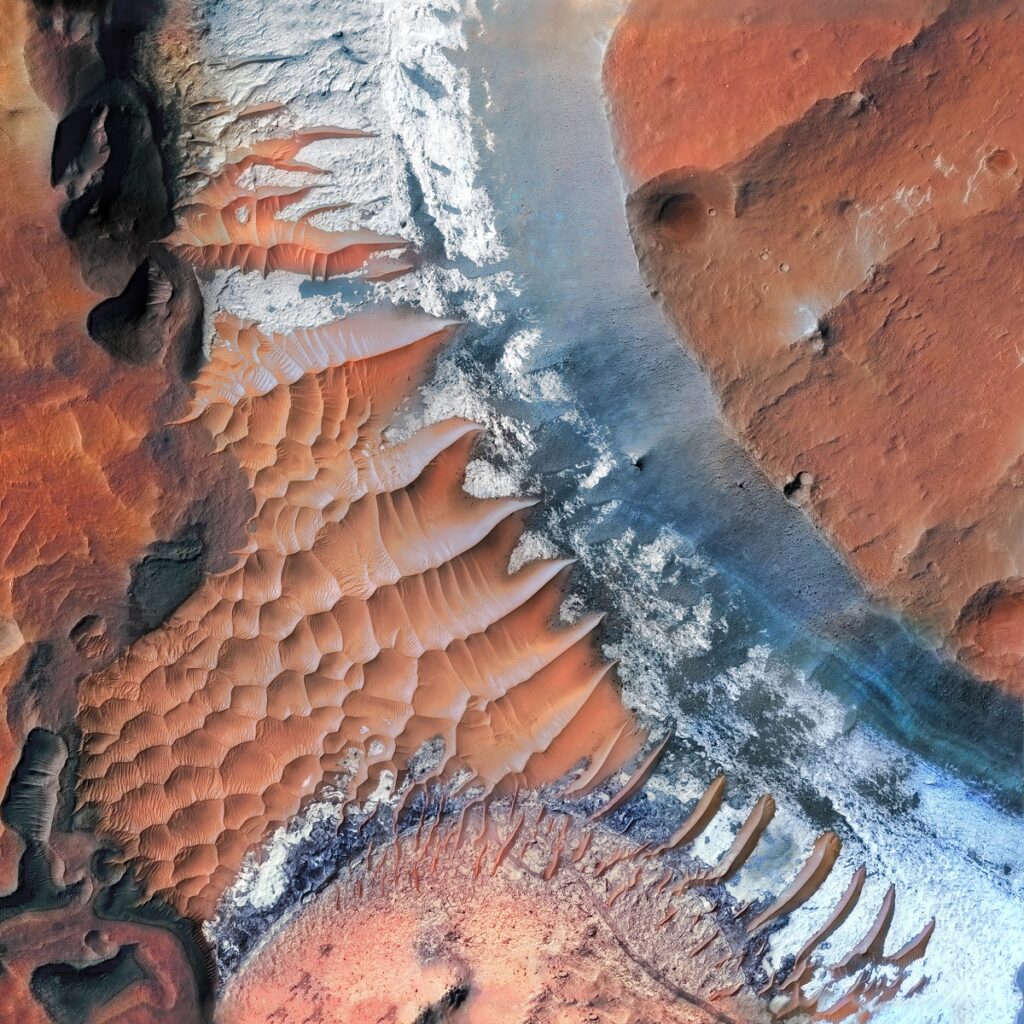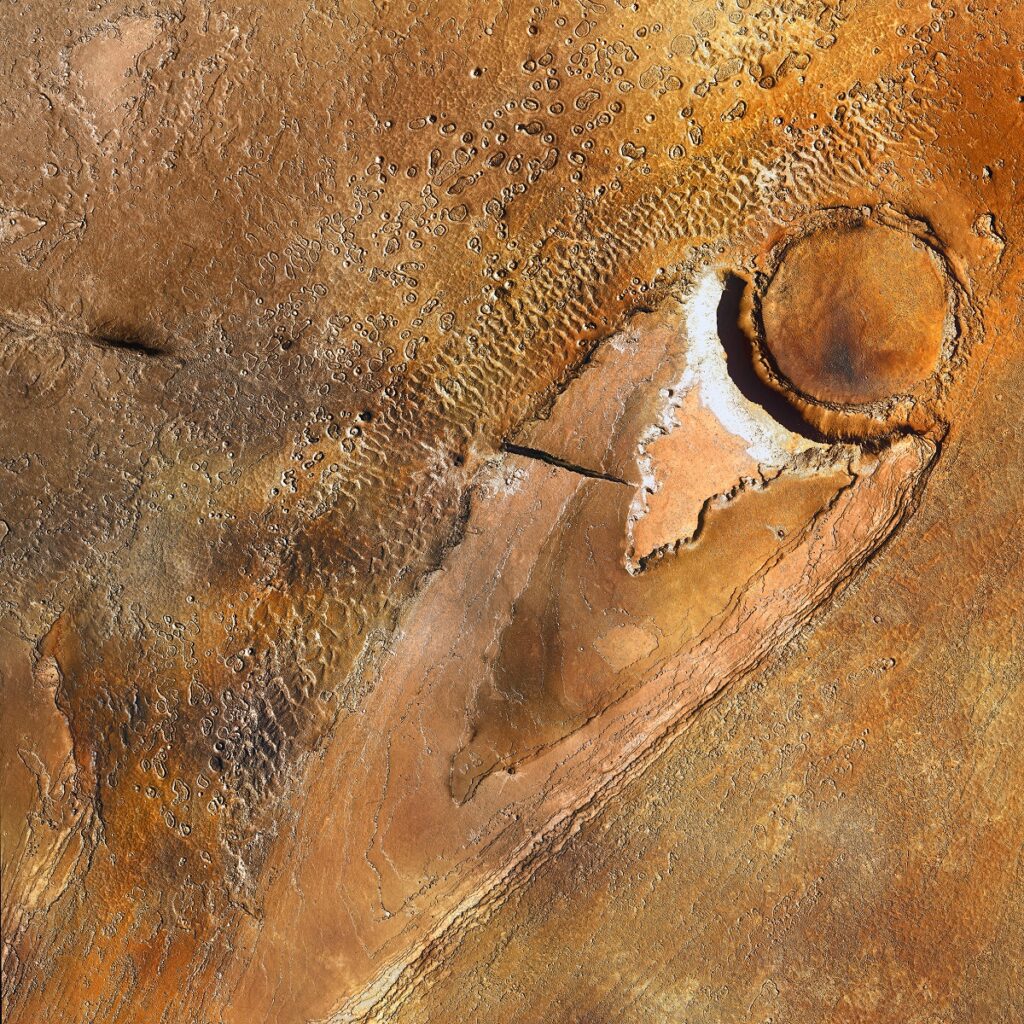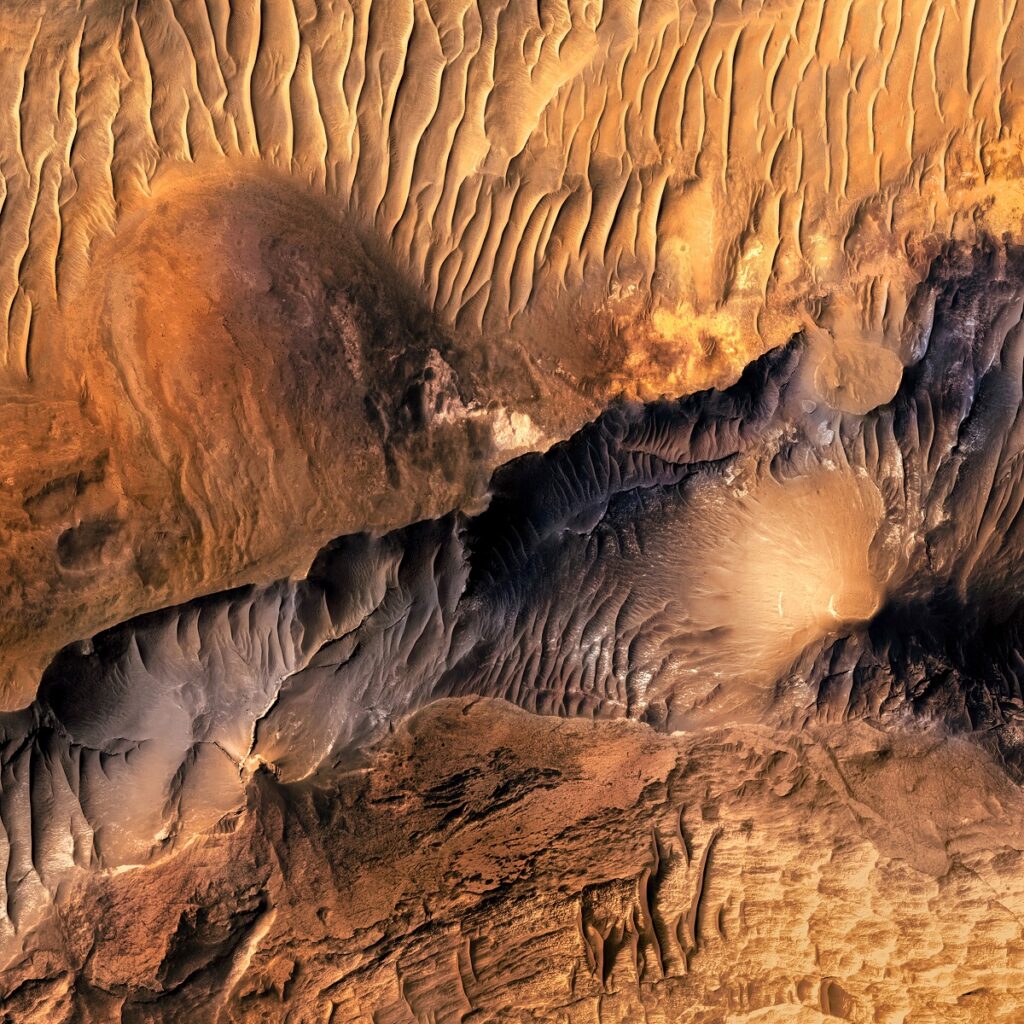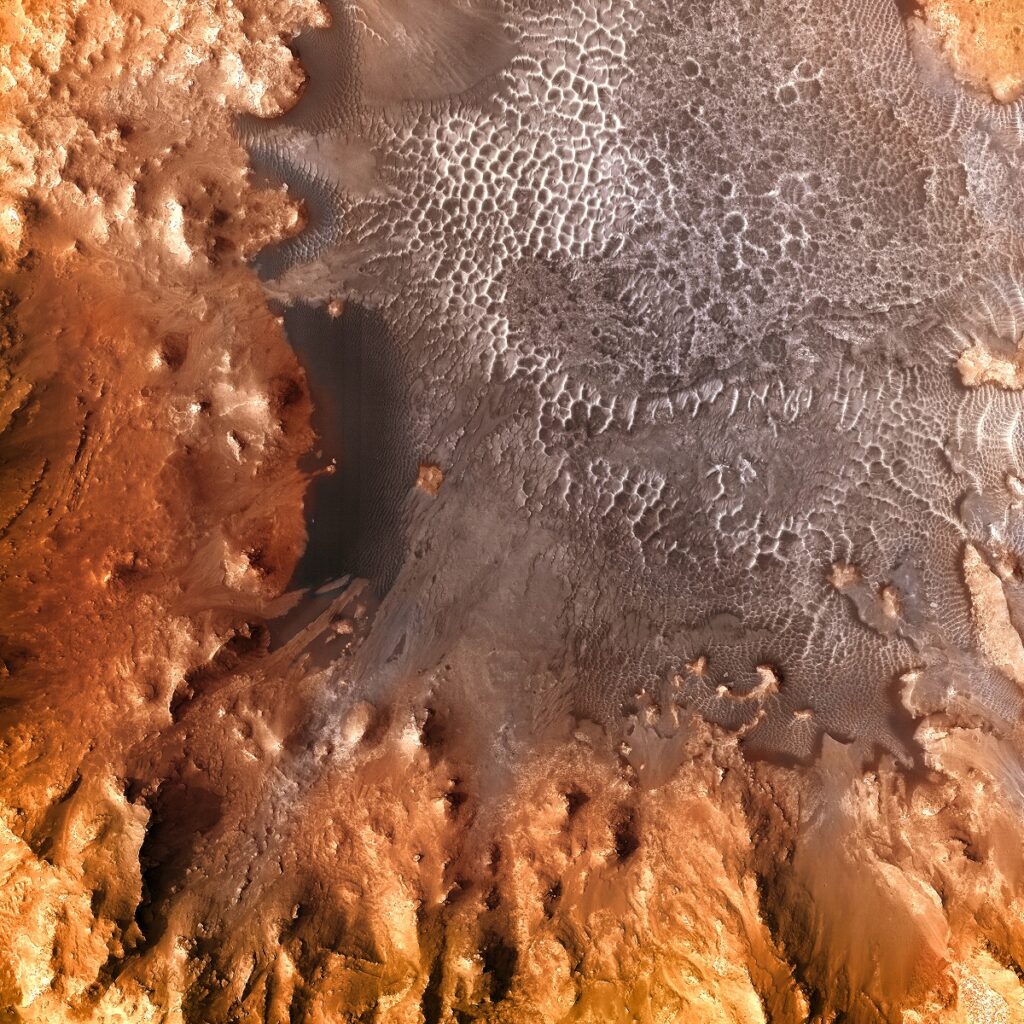Top 10 Tallest Volcanoes on Mars
Top 10 Tallest Volcanoes on Mars
WhiteClouds Builds 3D Marscapes and Canvas Prints
Did you know we make custom
8K Mars Canvas Prints
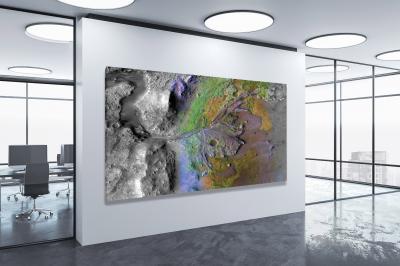
and
3D Marscapes
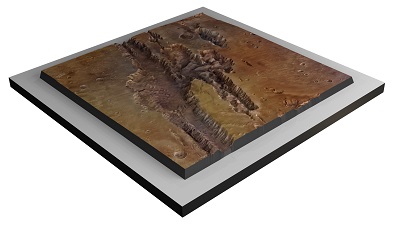
Prepare yourself for an unforgettable journey across the Martian landscape that will leave you awestruck and craving for more! We’re not just talking about any ordinary craters or plateaus. No, we’re delving deep into the towering behemoths that are the volcanoes of Mars—the molten gods that have shaped the Red Planet’s history and continue to captivate our imagination. From Olympus Mons, the unparalleled titan that dwarfs every volcano in our solar system, to less-known but equally fascinating volcanic formations, this countdown of the top 10 tallest volcanoes on Mars promises to be a thrilling roller coaster ride through geology, history, and the cosmic wonders that await us in outer space!
#1: Olympus Mons (13.6 Miles)
There’s no contest; Olympus Mons, located in the Tharsis Montes region, is the ultimate ruler in the realm of volcanic mountains, dwarfing all contenders not just on Mars but throughout the entirety of our solar system. Standing at an eye-watering height that’s nearly triple that of Earth’s Mount Everest, Olympus Mons commands respect and awe. If you were to place its vast base on Earth, it would stretch so widely that it would nearly swallow the entire state of Arizona! Inspired by the grandeur of Mount Olympus, the mythical abode of the Greek gods, Olympus Mons carries its name with appropriate majesty. Surprisingly, this enormous mountain isn’t just an ancient relic; geological signs suggest that it might have erupted as recently as 2 million years ago—mere moments in geological epochs. As if its colossal size weren’t awe-inspiring enough, the peak of this gargantuan mountain reaches into an environment where the Martian atmosphere is practically nonexistent. This has led some visionaries to fantasize about Olympus Mons being the inaugural extraterrestrial summit scaled by intrepid human mountaineers in the future.
#2: Ascraeus Mons (11.2 Miles)
Rising impressively in the immense Tharsis plateau, Ascraeus Mons may be overshadowed by its monumental sibling, Olympus Mons, but it boasts remarkable characteristics of its own. Often referred to as the younger and smaller kin to the king of Martian volcanoes, Ascraeus Mons distinguishes itself through unique geological features—most notably, icy patches discovered near its towering summit. These icy formations aren’t the volcano’s only claim to fame; Ascraeus Mons also has captivating gullies, which have sparked tantalizing theories about the presence of liquid water in Mars’ distant past. What’s even more intriguing is the scientific speculation that hidden subsurface ice could still exist within the volcano. This possibility makes Ascraeus Mons an incredibly attractive target for future space missions that could dig deeper, both literally and metaphorically, into the secrets that this icy sentinel may be hiding.
#3: Arsia Mons (10 Miles)
Though Arsia Mons may be a touch shorter than its colossal siblings in the famed Tharsis region, it carries an intriguing narrative of its own that has captivated astrogeologists and planetary scientists alike. With its towering height of 10 miles, it’s anything but small. Interestingly, some leading scientists postulate that this currently dormant volcano could have been a sanctuary for life in the past. Deep within its subterranean caves and labyrinthine passages, there may have been conditions suitable for some form of microbial life. These features add a layer of potential biological complexity to Arsia Mons that is both tantalizing and mysterious. Its gigantic caldera measures an astonishing 72 miles in diameter, providing compelling evidence that this volcano was once the site of catastrophically powerful eruptions that shook the Martian landscape. Popular imagination has even dubbed Arsia Mons as the potential future site for Martian geothermal energy plants, a testament to its enduring fascination and the role it may yet play in the human exploration of Mars.
#4: Pavonis Mons (8.7 Miles)
Strategically located near Mars’ equator, Pavonis Mons stands as an intriguing central spire amidst the other towering volcanic formations of the Tharsis region. Its equatorial location has sparked vibrant discussions and tantalizing speculations about using its summit as a future hub for a Martian space elevator, potentially revolutionizing how cargo and even people could be transported to and from the planet’s surface. Beyond these sci-fi dreams, Pavonis Mons holds geological wonders that have intrigued scientists for years. Its plateau is carved with enigmatic rift valleys, geological formations that may hold clues to the planet’s volcanic history and tectonic activities. These rift valleys have become the object of focused research and are regularly cited in academic papers, making Pavonis Mons a central figure in ongoing efforts to unravel the complex geological tapestry of the Red Planet.
#5: Elysium Mons (7.8 Miles)
Set apart from the cluster of volcanic behemoths in the Tharsis region, Elysium Mons has the distinction of being the most massive volcano in the distant Elysium Planitia area. Its relative geographic isolation makes it an exceptional focal point for in-depth scientific scrutiny. The fact that it stands alone suggests that Elysium Mons might serve as a window into a different epoch of Martian volcanic activity, perhaps one governed by differing geological forces or magma compositions. Researchers are particularly keen on its unique geochemical properties, which could provide unparalleled insights into the interior structure and evolution of Mars. The mysterious nature of Elysium Mons, coupled with its towering height of 7.8 miles, gives it a unique allure. Scientists consider it a treasure trove of untapped information, holding the promise of groundbreaking discoveries that could redefine our understanding of Martian geology and even the planet’s suitability for future colonization.
#6: Hecates Tholus (5.4 Miles)
Located in the Elysium Plantia, and standing tall as one of Mars’ ancient volcanic wonders, Hecates Tholus has a history that boggles the mind, stretching back an astonishing 3.8 billion years into the mists of Martian time. With such an extended chronology, it’s hardly a surprise that this edifice showcases a multifaceted geological tapestry that intrigues and challenges astrogeologists. Among its many captivating features is a dramatically collapsed caldera, which acts as a window into its tumultuous past. But that’s not all; Hecates Tholus is also marked by evidence of glacial activity. Yes, you read that correctly: a Martian volcano with glaciers. The combination of these two diametrically opposite features—a fiery crater and icy traces—makes Hecates Tholus a multidimensional character in the Martian landscape, one begging to be studied in greater depth. Each crevice and layer could hold clues to Mars’ climatic and geological history, making it a compelling subject for ongoing research and future Mars missions.
#7: Albor Tholus (4.8 Miles)
Albor Tholus is the stuff of geological mystery novels—if such a genre existed. Situated in the same expansive plain as Hecates Tholus, Elysium Plantia, Albor Tholus seems almost to rebel against typical volcanic architecture. Its unique topography features a flat summit and irregular, almost squashed, features that leave even seasoned scientists scratching their heads. What could have caused this peculiar shape? The prevailing hypothesis proposes a history fraught with violent eruptions followed by significant structural collapses. Yet, no one can say for sure, adding to its enigma. It’s as if Albor Tholus is a cryptic puzzle waiting for the right scientist, or perhaps the right Martian mission, to come along and solve its riddles. Its mysterious demeanor and unorthodox structure make it a siren call for geologists and planetary scientists, who view it as a living laboratory to explore volcanic evolution and geological transformations that are yet to be understood.
#8: Hadriacus Mons (4 Miles)
As you venture into the Hellas Plantia region, Hadriaca Patera emerges as a distinctive feature on the Martian surface, unlike any of its volcanic kin. Most striking is its shallow, expansive crater, which appears almost like an ancient amphitheater designed by nature. Further adding to its unique profile are signs of pyroclastic flows, indicating a history of explosive volcanic eruptions unlike the more typical, effusive lava flows often associated with Martian volcanoes. What’s even more fascinating is that researchers speculate this explosiveness might have been amped up by interaction with ice or water. The prospect that Hadriaca Patera’s violent eruptions might have been facilitated, or even amplified, by the presence of these elements not only intensifies our curiosity about its own history but also fuels speculation about Mars’ watery past. Was Hadriaca Patera once a hotbed of hydro-volcanic activity? Could it offer further clues about Mars’ capability to support life, even if it’s microbial? Such tantalizing questions make Hadriaca Patera a must-study site for astrogeologists and planetary scientists aiming to unlock the hidden chapters of Martian history.
#9: Tyrrhena Patera (1.2 Miles)
Tyrrhena Patera, located in the Hesperia Planum region, may not dominate the Martian skyline with a towering elevation, but what it lacks in stature, it abundantly compensates for with its captivating historical tale. With an age that stretches far back into the Martian past, this extensively eroded volcanic formation serves as a living textbook on various planetary forces. Its weathered features offer an invaluable glimpse into Martian wind patterns that have evolved over eons, acting as nature’s own anemometer and providing a unique setting for the study of atmospheric dynamics. Beyond wind erosion, its oddly smooth plains hint at a more complex narrative, stirring speculation among scientists that Tyrrhena Patera could hold clues to ancient aquatic conditions on Mars. These smooth surfaces, unlike anything seen on its more towering counterparts, suggest the past presence of liquid forces, possibly water, that wore down its jagged features into plains of uncanny smoothness. As a result, Tyrrhena Patera isn’t just a geological feature; it’s a complex archive of Martian history, awaiting in-depth study to reveal its long-held secrets. Because of its unique combination of erosional features, it’s considered a must-see for future missions aiming to unravel the intricate interplay of wind, water, and volcanic activity that has sculpted the Red Planet’s enigmatic landscape over billions of years.
#10: Ulysses Tholus (1 Mile)
In a list populated by Martian giants, Ulysses Tholus may appear to be the underdog of the bunch, but don’t let its relatively modest height fool you. Nestled within the expansive Elysium Planitia, this diminutive volcanic structure has its own unique allure that captivates scientists and space enthusiasts alike. While it may be dwarfed by its more grandiose neighbors, Ulysses Tholus packs a potent punch of geological intrigue in its compact form. The volcano’s unique shape and surface features make it an enigma that has sparked numerous debates in the scientific community. Its unusual morphology—ranging from collapsed calderas to small fissures—hints at a turbulent past marked by cycles of eruption and dormancy.
What adds to the allure of Ulysses Tholus is its relatively unexplored status. Despite its smaller size, the volcano has not received as much attention from missions and telescopic observations as have its more towering kin. This makes it fertile ground for discovery, where every rock and crevice could hold the key to unlocking new understandings of Martian volcanic activity and planetary formation. Some researchers speculate that its hidden crannies may even hold preserved signs of ancient microbial life or unique mineral compositions yet to be discovered.
As we conclude this awe-inspiring odyssey through the top 10 tallest volcanoes on Mars, it’s crucial to recognize that each volcano is not just a towering mass of rock and ash, but a treasure trove of scientific knowledge. From Olympus Mons, the colossal titan that dwarfs all earthly peaks, to the enigmatic Ulysses Tholus, the underdog with untold stories, these Martian masterpieces offer us an unprecedented glimpse into the Red Planet’s tumultuous geological past, as well as tantalizing possibilities for its future.
Check out our 3D Mars Learning Center for more information on Mars and its tallest volcanoes. You can also learn more at: NASA Mars Exploration.
More About Mars
Contact us today to learn more about our 3D services and how we can help you achieve your goals.
